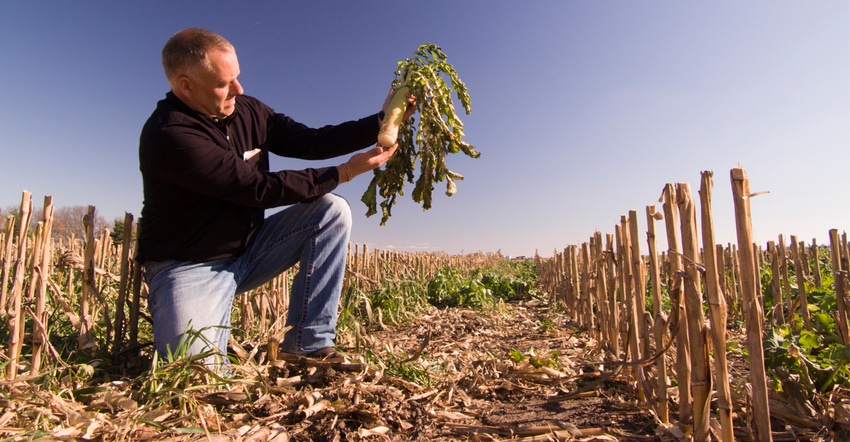March 13, 2018

The American Soybean Association presented Mark Schleisman, who farms near Lake City in western Iowa, the 2018 National Conservation Legacy Award during the annual ASA Awards Banquet Feb. 28 at the Commodity Classic in Anaheim, Calif.
Prior to Schleisman’s recognition as the program’s national winner, he was named Midwest Regional winner of the Conservation Legacy Award. The national winner is chosen from three regional winners. The other 2018 regional winners were Dave and Linda Burrier, Union Bridge, Md. (northeast region) and Grant Norwood, Mansfield, Tenn. (south region).
The program is designed to recognize outstanding environmental and conservation achievements of soybean farmers, which help to produce more sustainable U.S. soybeans. Along with ASA, the program is co-sponsored by BASF, Monsanto, Corn & Soybean Digest magazine, the United Soybean Board and Valent.
Document feed value of cover crops
Schleisman heads up M&M Farms, a diverse family operation in Calhoun County, Iowa. M&M Farms has 4,500 acres of crops, including 2,000 acres of popcorn; manages 360 cow-calf pairs; and finishes approximately 30,000 head of pigs.
With livestock being such an important part of the M&M Farms operation, Schleisman was approached by Practical Farmers of Iowa to do a three-year research project documenting the economic benefits of cover crops and grazing. He and three other farmers documented the feed value of the biomass produced by cover crops.
“The amount of cover crop growth we get is very weather-dependent, but we have seen a value of $70 an acre or more, with our top year coming in at $76 an acre,” Schleisman says. “The benefit to the cows is tremendous.”
The family started with cereal rye as its choice for a cover crop and now is adding other species such as oilseed radishes and rape. “The cows seem more satisfied on the cover crops because they are not just eating dried-up cornstalks, but getting some green material in there,” Schleisman notes.
‘3 times’ return on cover crop by grazing
The economic benefits became obvious quickly. “By our numbers, we are getting at least a three-times return in the short term by grazing the cover crops, in addition to long-term benefits we are seeing in soil health,” Schleisman says. The soil health benefits realized on M&M Farms led them to also plant cover crops on fields where they don’t have cows graze.
M&M Farms also strives to protect water quality. Located in the Elk Run watershed, a tributary to the Raccoon River, the area is a source of concern about nitrates. As part of a demonstration project directed by the Iowa Soybean Association in cooperation with partner organizations, Schleisman installed edge-of-field practices designed to significantly cut nitrate contribution to the Raccoon River.
One of these practices is a saturated buffer. It stores water under field buffers by diverting tile water into shallow laterals that raise the water table within the buffer, thus slowing outflow. The other edge-of-field treatment process is a bioreactor. It consists of a buried pit filled with a carbon source (wood chips) through which tile water is diverted.
The carbon provides a food source for microorganisms; they use nitrate to metabolize the carbon, converting the nitrate to harmless atmospheric nitrogen gas. “I’ve seen nitrate levels entering the bioreactor running 15 to 22 parts per million,” Schleisman says. “The water is exiting the bioreactor with nitrate at less than 1 part per million.”
He has shared that story with many farm audiences and has been featured in many interviews conducted for urban audiences as well.
There are many more innovative and sustainable practices that Schleisman and other recipients of the 2018 Conservation Legacy Awards are putting into action on their farms today. Click here to see a special insert on the winners. Videos on each of the winning operations are available here.
Source: American Soybean Association
You May Also Like




